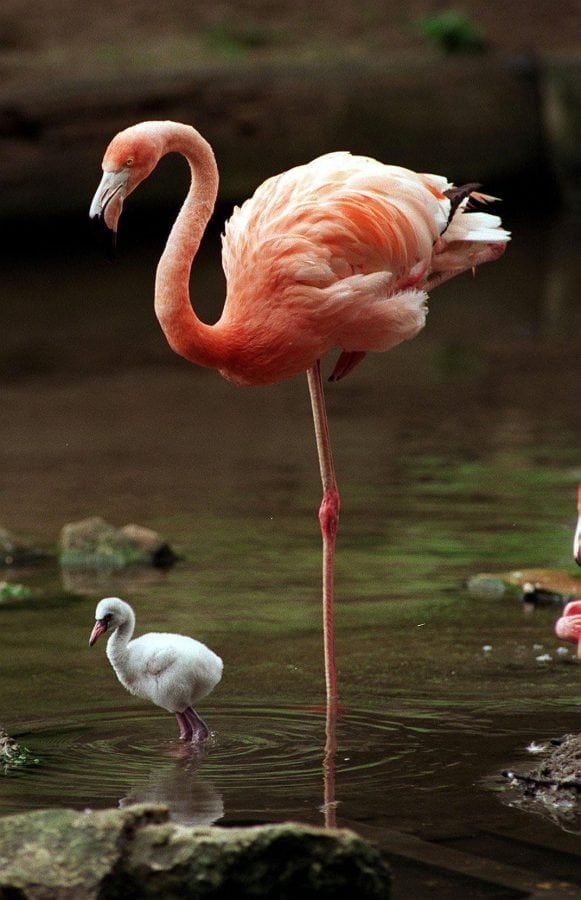A flamingo stands on one leg because it takes less effort than using two, according to new research.
It is possibly the animal kingdom’s most iconic pose and the reason for it has remained one of the greatest mysteries in nature.
Now, in the first study of its kind, scientists reckon they have come up with a simple solution.
The famous long necked pink bird with stick like legs, which at five feet tall is among the biggest on Earth, would risk toppling over if it didn’t!
The simple explanation came about after they carried out biomechanical experiments using flamingos’ dead bodies.
Dr Young-Hui Chang, of Georgia Institute of Technology, said: “We found a stable joint configuration could only be achieved when placing the cadaver such that the foot was directly beneath the body, as adopted in one-legged standing.”
For example, this remained fixed when the tibiotarsus, the long bone between its thigh and foot, was moved 20 degrees towards the axis of its body.
Flamingoes have unusually large feet, which may make getting its balance right more difficult.
Added Dr Chang: “When aligned vertically, approximating a two-legged stance, the joints rapidly became unstable and could no longer support the body weight.”

His team acquired two fresh-frozen adult Caribbean flamingo cadavers from Birmingham Zoo, Alabama, and, after thawing them, used bone clamps to emulate its one-legged stance.
They tilted the body forwards and backwards in the sagittal plane, which divides the body into left and right, while tracking limb segment markers to calculate knee and hip joint angles.
Dr Chang said: “With the bulk of its mass sitting half a metre above the ground on a single, slender leg, the one legged stance of flamingoes captures the imagination and epitomises a behaviour that is unique to birds.
“Here, we explain how flamingoes use their body’s biomechanics to support their weight on one leg with little muscular effort and why standing on one leg may actually be energetically favourable to standing on two legs.
“We believe reducing the muscular force of standing could offer a more general explanation of why many bird species across many habitats stand and even sleep on one leg.”
Previous research has suggested flamingoes stand on one leg to reduce muscle fatigue or heat loss, but Dr Chang believes this is wrong.
He said: “To our knowledge, this is the first functional investigation of one legged
standing in flamingoes to explore both musculoskeletal anatomy and behaviour.”
Others birds, such as herons, storks, ducks and many others also often stand on a single leg in water, perhaps for the same reasons as flamingoes.
Dr Chang said: “First, we demonstrated flamingo cadavers could passively support body weight on one leg without any muscle activity while adopting a stable, unchanging, joint posture resembling that seen in live flamingoes.
“By contrast, the cadaveric flamingo could not be stably held in a two-legged pose, suggesting a greater necessity for active muscle force to stabilise two-legged versus one-legged postures.”
His team also analysed video recordings of eight juvenile Chilean flamingoes taken at Zoo Atlanta, Georgia, as they stood on a force plate.
Trials included visibly active (eyes-open) and quiescent (eyes-closed) birds standing on one and two legs.
Dr Chang said: “We discovered live flamingoes standing on one leg have markedly reduced body sway during quiescent versus alert behaviours.”
He added: “Taken together, our results highlight the possibility flamingoes stand for long durations on one leg without exacting high muscular forces and, thus, little energetic expenditure.”
Dr Chang, whose findings are published in Biology Letters, said flamingoes mainly use their legs for prolonged standing, rather than moving, so it seems using just one should be “energetically efficient.”
Other benefits, such as reduced heat loss, may not be as important for non aquatic and tropical birds that also stand on one leg.
He explained: “We, therefore, propose the hypothesis that rather than to reduce muscle fatigue or heat loss, flamingoes stand on one leg to reduce muscular energy expenditure.
“While we lack direct evidence, reduced energy expenditure could more generally explain how many birds with varied morphologies and ecological niches can benefit from this uniquely avian behaviour.”

